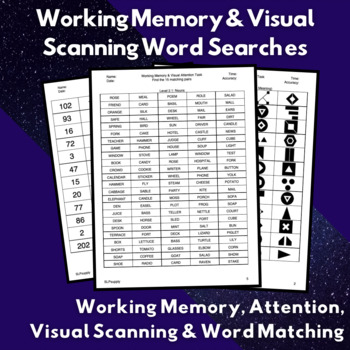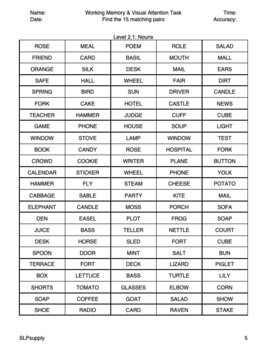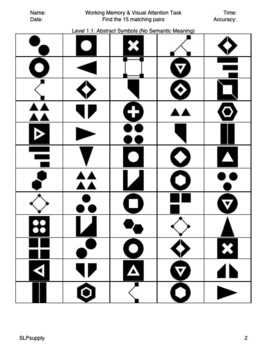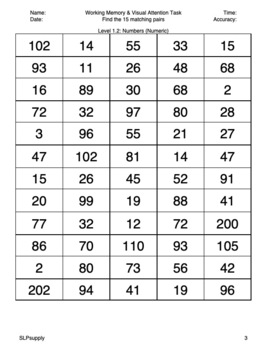Working memory & visual scanning word search (Executive functioning, aphasia)
- PDF
Description
This activity consists of 13 visual scanning/working memory tasks of varying difficulty and cognitive-linguistic targets. Each page contains 15 exactly matching pairs of words, numbers, or symbols. The goal is to find all fifteen. This task draws on cognitive-linguistic skills of working memory, executive functioning, and visual scanning. See preview for a downloadable freebie!!!
Goal areas:
· Working memory
· Attention
· Visual scanning
· Neglect
· Letter, word, number & symbol recognition & identification
· Matching
· Visual processing
· Sustained attention/endurance & fatigue
Deficits in the above areas have implications for functional tasks of and social participation such as shopping, locating personal items, driving, wayfinding, socializing, reading, understanding documents and notes, working, and more.
Instructions:
1. Provide a printed worksheet of the task along with a pen or highlighter
2. Instruct client to find the 15 exact pair matches.
NOTE: Some words, symbols, or numbers may look similar or may be rotated, but there are only 15 exact match pairs on each worksheet. Answer key is available at the end.
3. Time how long the client takes to complete the task along with the ate and how accurate their answers are – this step is optional but may be helpful if you want to compare scores over time.
4. You may wish to take notes on your observations regarding the following:
- Does the client have a strategy to finding the pairs, or are they looking randomly? Do they do better if taught strategies or reminded of existing strategies?
- Are there consistent patterns to the mistakes they are making, if any? For example: semantic interference, consistently missing one side of the page, numerals are okay but written numbers are not, alexia, etc.
- Does the client show signs of visual inattention/neglect?
- How long can the client work on one activity before fatigue sets in? Are they able to recognize their own fatigue?
- If additional distractors are present (such as radio, TV, conversation), how does the client perform- are they able to improve over time?
Other reading:
- Nikravesh, M., Aghajanzadeh, M., Maroufizadeh, S., Saffarian, A., & Jafari, Z. (2021). Working memory training in post-stroke aphasia: Near and far transfer effects. Journal of communication disorders, 89, 106077. Chicago.
- "Individuals with aphasia (IWA) show various impairments in speech, language, and cognitive functions. Working memory (WM), a cognitive system that functions to hold and manipulate information in support of complex, goal-directed behaviors, is one of the impaired cognitive domains in aphasia...Given the good generalizability of the WM training program on both WM and language performance, WM training is suggested as part of the rehabilitation program in aphasia."
- Turner-Strokes, L. (Ed.). (2003). Rehabilitation following acquired brain injury: national clinical guidelines. Royal College of Physicians.
- “Guideline 121: Patients with persistent cognitive deficits following ABI should be offered cognitive rehabilitation… which may include:
- Rehabilitation interventions management in a structured and distraction-free environment and targeted programmes for those with executive difficulties (ie problems with planning, organisation, problem solving and divided attention) attempts to improve attention and information processing skills
- “Guideline 110: Patients presenting with persistent visual neglect or field defects should be offered specific retraining strategies.”
- Nikravesh, M., Aghajanzadeh, M., Marousfizadeh, S., Saffarian, A., & Jafari, Z. (2020). Working memory training in post-stroke aphasia: near and far transfer effects. Journal of Communication Disorders. https://doi.org/10.1016/j.jcomdis.2020.106077
- “The treatment group showed significant improvements in both WM and language performance compared to the control group. The findings were in line with multiple past studies that demonstrate the positive impacts of repetition- and recognition-based [working memory[ training on [working memory] function and capacity, as well as on language domains in aphasia (Francis et al., 2003; Kalinyak-Fliszar et al., 2011; Majerus et al., 2005; Majerus, 2018; Mayer & Murray, 2002; Salis, 2012; Vallat-Azouvi et al., 2014; Vallat-Azouvi et al., 2005; Zakariás, Kelly et al., 2018).”
- This group developed their own battery of working memory tasks but found improvements in their study. They found that the treatment group improved in working memory as well as other language skills (fluency, naming, repetition, & auditory comprehension.
#aphasia #aphasiatherapy #walc #adults #cognitivetherapy #cognitivecommunicationdisorders





